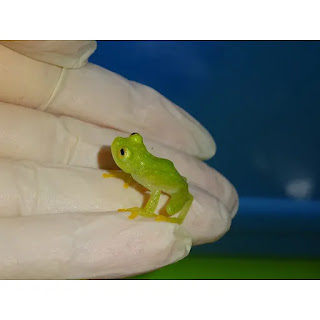🐸 Glass Frog (Scientific Family: Centrolenidae)
🧬 Overview
The glass frog gets its name from the translucent or transparent skin on its underside (belly), which makes it possible to see its internal organs — including the heart, liver, intestines, and sometimes even blood vessels — with the naked eye.
🌎 Habitat
-
Location: Central and South America
-
Found in countries like:
-
Costa Rica
-
Panama
-
Colombia
-
Ecuador
-
Peru
-
-
Environment: Moist tropical rainforests, often near streams or rivers, where they breed and lay eggs.
🧪 Physical Features
-
Size: Small (about 1.9 to 3 cm or 0.75 to 1.2 inches in length)
-
Color: Bright green on top to blend with leaves
-
Belly: Translucent or fully transparent
-
Eyes: Forward-facing, giving it a cartoon-like appearance
🧠 Why It’s So Interesting
-
You can literally see:
-
Its heart beating
-
Its food digesting
-
Its tiny organs working in real time
-
-
Biologists and medical researchers are fascinated by glass frogs because they provide a natural “living window” into anatomy.
🐣 Reproduction & Parenting
-
Males call to attract females and defend their territory.
-
Eggs are laid on leaves overhanging streams.
-
Some male glass frogs guard the eggs, keeping them moist and safe from predators.
-
Once hatched, the tadpoles drop into the water below.
🛡️ Camouflage and Survival
-
The transparent belly makes it harder for predators below (like birds or fish) to see them.
-
Their backs are green, helping them blend with foliage from above.
🔬 Scientific Use
Glass frogs are of interest to scientists studying:
-
Biological transparency
-
Heart and organ development
-
Environmental health, as they are very sensitive to pollution

.jpeg)

.jpeg)







.jpeg)


0 Comments